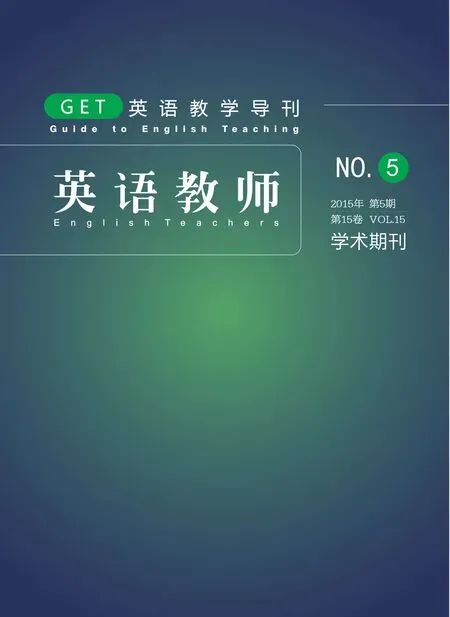評判性閱讀的教學(xué)設(shè)計與實施
——以人教版Book 4 Unit 4 Communication,No Problem?為例
貴麗萍
評判性閱讀的教學(xué)設(shè)計與實施
——以人教版Book 4 Unit 4 Communication,No Problem?為例
貴麗萍
【摘要】文章通過對一節(jié)閱讀課教學(xué)課例的呈現(xiàn)與評析,探討在高中英語閱讀課中如何進行評判性閱讀教學(xué)的實踐嘗試,引導(dǎo)學(xué)生運用評判性閱讀策略對文本進行深層次探究,培養(yǎng)學(xué)生的評判性思維能力及主動獨立的閱讀習(xí)慣。
【關(guān)鍵詞】閱讀;評判;思維能力;閱讀習(xí)慣
一、前言
閱讀課應(yīng)帶領(lǐng)學(xué)生讀懂、讀細、讀深文本,從而達到對文本的深層次理解,它包括對語言內(nèi)容的關(guān)注、文本信息的理解和處理以及對文本的深層次探究。目前大多數(shù)高中英語閱讀課的設(shè)計僅僅停留在對文本信息的淺層次理解上,教師設(shè)計往往是通過一些判斷正誤、填寫表格信息、尋找主題句等來處理文本的一些表層信息,卻未引導(dǎo)學(xué)生對文本進行深層的理解。高中英語閱讀課不僅要幫助學(xué)生對語言和信息進行表層的理解,而且還要幫助學(xué)生對文本進行深層次的挖掘,關(guān)注作者觀點、情感態(tài)度和寫作意圖,把握文本的脈絡(luò)層次和結(jié)構(gòu)特點,了解文本的遣詞造句和謀篇布局等方面的技巧,進而鑒賞語言文化(葛炳芳2010)。因此,引導(dǎo)學(xué)生對文本進行深層次的理解應(yīng)成為高中英語閱讀課的一個重要目標,學(xué)生只有通過對文本的深層解讀,才能真正理解語篇,體驗真正開放性的、富有深度思維層次的閱讀能力訓(xùn)練。
評判性閱讀是一種深層次的閱讀,讀者應(yīng)該能夠認知(know)、理解(comprehend)、應(yīng)用(apply)、分析(analyze)、綜合(synthesize)和評價(evaluate)文本信息,并將文本信息與個人原有的經(jīng)驗聯(lián)系起來,解讀比喻性語言、判斷作者的寫作目的、評價作者的觀點,并且將文本的觀點運用于讀者實際經(jīng)歷過的情景當(dāng)中(梁美珍2012)。在日常教學(xué)中,筆者嘗試運用評判性閱讀模式,引導(dǎo)學(xué)生在理解文本表層信息的基礎(chǔ)上,運用分析、比較、預(yù)測、推斷、概述、提問、評價等評判性閱讀策略達到對文本的深層次理解,從而培養(yǎng)學(xué)生在閱讀中發(fā)現(xiàn)、探究、分析、判斷、解決問題的能力和評判性思維能力。本文以一節(jié)閱讀課為例,探討在高中英語閱讀課中如何進行評判性閱讀教學(xué)的實踐嘗試。
二、課例呈現(xiàn)與評析
(一)課例背景與教學(xué)內(nèi)容介紹
本單元的中心話題是身勢語(body language)。與有聲語言一樣,身勢語也是文化的載體。Reading部分Communication,No Problem?以當(dāng)今世界文化交匯的十字路口(首都國際機場)為背景,講述了來自幾個不同國家的學(xué)生由于文化背景的差異及問候身勢語不同而帶來的一些小誤會。該文本是一篇記敘性的說明文,常規(guī)的閱讀課設(shè)計會把這篇文章處理成簡單的信息查尋和接收;從評判性閱讀的角度思考,則可對文本進行更深層次的解讀,教學(xué)設(shè)計側(cè)重語篇理解、文本結(jié)構(gòu)分析、作者寫作意圖的把握及跨文化交際意識的提升。筆者在設(shè)計這節(jié)Communication,Noproblem?閱讀課時,引導(dǎo)學(xué)生在認知、理解文本表層信息的基礎(chǔ)上,運用批判性閱讀策略,分析文章的謀篇布局,挖掘文本的隱藏含義或寓意,深入理解話題,培養(yǎng)評判性思維能力。
(二)教學(xué)環(huán)節(jié)設(shè)計與評析
Step 1. Lead-in問題導(dǎo)入
1.PPT呈現(xiàn)一個十字路口的圖片(如圖1所示),引出文本關(guān)鍵詞:culturalcrossroads,教師提問:
Q1:When two roads meet,we get a crossroads. Then when two cultures meet,what do we get?(key:cultural crossroads)
Q2:When you are at a cultural crossroads and you don’t understand each other,how can you communicate?(key:body language)
Q3:What is body language? What body languages do people often use when communicating? (key:non-verbal communication./ gestures;facial expressions;eye contact;posture;physical distance)

圖1

圖2
【設(shè)計說明】簡單、直接導(dǎo)入話題,引發(fā)學(xué)生思考,形象地引出本文的關(guān)鍵詞組cultural crossroads及本文的話題body language。Q3的設(shè)計用圖片(圖2)引出答案,讓學(xué)生初步熟悉文本中的部分生詞。這三個問題的設(shè)計目的都在于激發(fā)學(xué)生的推理、分析及發(fā)散性思維能力,同時讓學(xué)生初步感知部分目標詞匯。
2.A Quiz about different greeting body languages
T:We are going to have a small quiz to see who in our class knows most about different greeting body languages in different countries. There are six statements here and some of them are not true. Let’s play a game. I would like all of you to stand up and see the statements are true or false. If you get the right answer,you’ll keep standing. Otherwise,you’ll sit down. The last one who remains standing will be the winner.
a. English people often stand close to others or touch strangers when they meet.
b. People from Jordan may move very close to you as you introduce yourself to them.
c. Americans and Canadians tend to greet each other with a nice gentle handshake.
d. In France, people kiss each other on the cheek.
e. American people need more personal space than we Chinese people do.
f. Native New Zealanders greet each other by touching noses.
【設(shè)計說明】這六句話的內(nèi)容與閱讀內(nèi)容有緊密的關(guān)聯(lián),教師在閱讀前導(dǎo)入部分以判斷正誤的方式激活學(xué)生原有的知識,并激發(fā)學(xué)生對不同文化中不同的問候方式產(chǎn)生興趣及質(zhì)疑,同時讓學(xué)生對即將閱讀的內(nèi)容有一定的預(yù)測。此外,游戲活動的方式可以提高學(xué)生的興趣和積極性。
Step 2. Title - reading標題設(shè)疑
讓不同的學(xué)生大聲朗讀課文的標題:Communi原cation,noproblem(看學(xué)生讀升調(diào)還是降調(diào),哪一種才是正確的讀法?)讓學(xué)生自己去思考在不同的文化中運用體勢語言交流是否存在問題。教師提問:Are there problems or not in body language communication ?
【設(shè)計說明】質(zhì)疑標題,引導(dǎo)思維。文章的標題Communication,no problem?是一個問句,所以,正確的讀法應(yīng)該是升調(diào)。通過引導(dǎo)學(xué)生對標題的探究和質(zhì)疑,學(xué)生的審題、推理、質(zhì)疑、判斷等思維能力得到了訓(xùn)練,對標題的理解和辨析能力也得到了提高,有助于對文本內(nèi)容的理解。
Step 3. Summarizing the main idea and analyzing the structure文章主旨及結(jié)構(gòu)理解
Activity 1:Summarizing the main idea
T:Read the passage fast to sum up the main idea
in no more than 40 words and share your answer with your partner. Please pay attention to the first and last sentences in each paragraph.
(key:The passage introduces some examples of different greeting body languages to show that body languages are different in different cultures. And the writer believes that understanding and studying different international customs can help avoid the difficulties in body language communication.)
Activity 2:analyzing the structure
T:The passage is written in the following four parts(Part1:background;Part2:problem-noticing;Part 3:problem-analyzing;Part 4:problem-solving). Read the passage again and find out which part each paragraph belongs to.

圖3

圖4
【設(shè)計說明】概括文章主旨大意及分析文章結(jié)構(gòu)是培養(yǎng)學(xué)生思辨能力的有效途徑,也是評判性閱讀的常用策略。Activity 1要求學(xué)生能區(qū)分主要和次要信息并概括文章主旨,從而掌握文章的大意。關(guān)注每段的首尾句是快速閱讀把握大意的閱讀策略訓(xùn)練,最后學(xué)生以pair work的方式分享答案,在交流合作中完成任務(wù)。Activity 2旨在引導(dǎo)學(xué)生了解這類文章的寫作結(jié)構(gòu),即在一定的背景下(background),發(fā)現(xiàn)一些問題(problem-noticing),然后對問題進行分析(problem-analyzing),最后是解決問題(problem-solving),通過這一活動指導(dǎo)學(xué)生理清文章的結(jié)構(gòu)以及作者的謀篇布局。以上兩個活動(圖3、圖4)幫助學(xué)生從宏觀角度準確理解文章主旨,把握文章的結(jié)構(gòu)脈絡(luò)及作者的行文思路。
Step 4. Reading for details文本細節(jié)分析推理
(1)Paragraph 1 Background:Read the first paragraph and answer the questions.
Q1:Which is the topic sentence?
Q2:Which sentence do you think can be omitted(刪去)without affecting the flow of the meaning?
Q3:Which word tells you these students are new to Beijing?(Key:curious)
【設(shè)計說明】這三個問題的設(shè)計都具有一定的挑戰(zhàn)性,學(xué)生必須深入理解這一段內(nèi)容才能完成。Q1的設(shè)計是因為該段的主題句具有一定的隱密性,學(xué)生必須充分讀懂文本才能找出;Q2的設(shè)計是考驗學(xué)生對文本的質(zhì)疑態(tài)度,并考查他們對主要信息及次要信息的辨析,此處有一句話可以刪去而不影響意義的連貫性;Q3要求學(xué)生能讀懂文字背后的信息,即read behind the lines。這三個問題是要求學(xué)生在理解文本表層意思的基礎(chǔ)上,運用評判性閱讀的質(zhì)疑、概括、分析、比較、推理等思維策略來解決問題。
(2)Paragraph 2&3 Problem-noticing:Read Paragraph 2&3,find out the three cultural mistakes (shocks)when they greet each other using different body languages.

CulturalShock Country Nam e Greeting body language cultural mistake 1 cultural mistake 2 cultural mistake 3
【設(shè)計說明】該活動旨在指導(dǎo)學(xué)生利用表格把文本中本來相對松散的描述信息轉(zhuǎn)化為直觀清晰的表格信息。在處理文本信息時,以話題為中心組織整理語言知識是一個有效地把語言知識和文本內(nèi)容相結(jié)合的方式。此活動能幫助學(xué)生抓住文章的細節(jié)信息,指導(dǎo)學(xué)生學(xué)會分析、重組、概括文本信息,從而更準確、全面地理解該部分內(nèi)容。
(3)Paragraph 4 Problem-analyzing:Read Paragraph 4,answer the following two questions.
Q1:Which sentence tells us the cause of these cultural mistakes?
(Key:Not all cultures greet each other the same way,nor are they comfortable in the same way with touching or physical distance.)
Q2:Can you tell the reason in your own words?
(Key:Problems occurs because of different cultures.)
【設(shè)計說明】該問題的設(shè)計旨在讓學(xué)生在文本中找出問題出現(xiàn)的原因后,能從自我角度進行思考,站在更高一層來審視問題出現(xiàn)的原因,最后引導(dǎo)學(xué)生認識到文化的不同會形成不同的body language,進而造成communication problems.
(4)Paragraph 5 Problem-solving:ways out.
Q1:What’s the writer’s opinion to solve the problem?(According to the writer, what should we do and what should we keep in mind?)
(Key:Action:Study different international customs.
Hidden information:When in Rome,do as the Romans do.
Awareness:These actions are not good or bad,but are simply ways in which cultures have developed.
Hidden information:We should respect different cultures.)
Q2:What is the hidden information behind his words?
Q3:How do you understand the sentence:Cultural customs for body language are very general——not all members of a culture behave in the same way.
【設(shè)計說明】這是文章的最后一段,作者對在當(dāng)今世界多元文化交匯時如何避免由于body language不同而造成的文化交流沖突提出自己的看法。這三個問題的設(shè)計目的在于幫助學(xué)生讀懂、讀細并理清信息,hidden information的設(shè)計是引導(dǎo)學(xué)生深層理解文字背后的含義。
Step 5.拓展延伸
Discussion:If you studied abroad,how would you get ready for cultural shocks?(or how to avoid the communication problems?)
【設(shè)計說明】該部分設(shè)計是對文章最后一段內(nèi)容的拓展延伸,通過口頭交際活動來強化學(xué)生對不同文化的背景下如何交流進行思考,引導(dǎo)學(xué)生對作者的觀點進行評價,并增加自己的觀點建議,形成自己的見解。最后教師總結(jié)出兩條原則:
a. When in Rome,do as the Romans do.
b. Understanding,respect and tolerance are keys to communication in today’s world of cultural crossroads.
三、結(jié)束語
在高中英語閱讀課中進行評判性閱讀教學(xué)具有可行性與可操作性,教師運用評判性閱讀模式進行閱讀課教學(xué)設(shè)計能更好地引導(dǎo)學(xué)生走近作者,走進文章,與他們產(chǎn)生共鳴,從而更好地把握文本的主題,體會作者的寫作意圖(貴麗萍2011)。評判性閱讀教學(xué)模式在高中英語閱讀課教學(xué)中還處于起步階段,是一種教學(xué)創(chuàng)新,希望有更多的一線教師能大膽嘗試,在實踐中進一步改善與豐富評判性閱讀的教學(xué)方法及活動設(shè)計。
引用文獻
葛炳芳.2010.High School Reading Instruction:A SIMPLE Perspective [J].一線教師,(2):4.
貴麗萍.2011.英語閱讀教學(xué)中的思維活動:評判性閱讀視角[M].杭州:浙江大學(xué)出版社:78.
梁美珍.2012. PIS閱讀素養(yǎng)測評對高中英語閱讀教學(xué)的啟示[J].中小學(xué)外語教學(xué),(2):36.
作者信息:324000,浙江衢州,浙江省衢州第二中學(xué)glplily72@163.com

